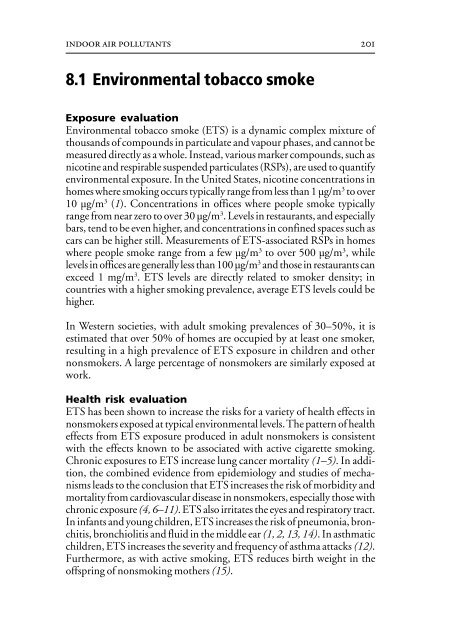Air Quality Guidelines - World Health Organization Regional Office ...
Air Quality Guidelines - World Health Organization Regional Office ...
Air Quality Guidelines - World Health Organization Regional Office ...
You also want an ePaper? Increase the reach of your titles
YUMPU automatically turns print PDFs into web optimized ePapers that Google loves.
indoor air pollutants<br />
8.1 Environmental tobacco smoke<br />
Exposure evaluation<br />
Environmental tobacco smoke (ETS) is a dynamic complex mixture of<br />
thousands of compounds in particulate and vapour phases, and cannot be<br />
measured directly as a whole. Instead, various marker compounds, such as<br />
nicotine and respirable suspended particulates (RSPs), are used to quantify<br />
environmental exposure. In the United States, nicotine concentrations in<br />
homes where smoking occurs typically range from less than 1 µg/m 3 to over<br />
10 µg/m 3 (1). Concentrations in offices where people smoke typically<br />
range from near zero to over 30 µg/m 3 . Levels in restaurants, and especially<br />
bars, tend to be even higher, and concentrations in confined spaces such as<br />
cars can be higher still. Measurements of ETS-associated RSPs in homes<br />
where people smoke range from a few µg/m 3 to over 500 µg/m 3 , while<br />
levels in offices are generally less than 100 µg/m 3 and those in restaurants can<br />
exceed 1 mg/m 3 . ETS levels are directly related to smoker density; in<br />
countries with a higher smoking prevalence, average ETS levels could be<br />
higher.<br />
In Western societies, with adult smoking prevalences of 30–50%, it is<br />
estimated that over 50% of homes are occupied by at least one smoker,<br />
resulting in a high prevalence of ETS exposure in children and other<br />
nonsmokers. A large percentage of nonsmokers are similarly exposed at<br />
work.<br />
<strong>Health</strong> risk evaluation<br />
ETS has been shown to increase the risks for a variety of health effects in<br />
nonsmokers exposed at typical environmental levels. The pattern of health<br />
effects from ETS exposure produced in adult nonsmokers is consistent<br />
with the effects known to be associated with active cigarette smoking.<br />
Chronic exposures to ETS increase lung cancer mortality (1–5). In addition,<br />
the combined evidence from epidemiology and studies of mechanisms<br />
leads to the conclusion that ETS increases the risk of morbidity and<br />
mortality from cardiovascular disease in nonsmokers, especially those with<br />
chronic exposure (4, 6–11). ETS also irritates the eyes and respiratory tract.<br />
In infants and young children, ETS increases the risk of pneumonia, bronchitis,<br />
bronchiolitis and fluid in the middle ear (1, 2, 13, 14). In asthmatic<br />
children, ETS increases the severity and frequency of asthma attacks (12).<br />
Furthermore, as with active smoking, ETS reduces birth weight in the<br />
offspring of nonsmoking mothers (15).<br />
201

















